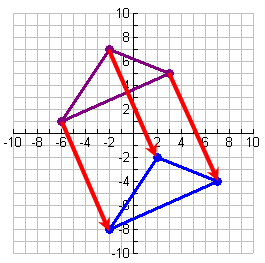Translation 2
First I created my original triangle ABC. From this triangle, I did a composition of translations to create a face-like shape, creating images of triangles A'B'C', A''B''C'', A'₁B'₁C'₁, A''₁B''₁C''₁, A'₂B'₂C'₂, A'₃B'₃C'₃, and A'₄B'₄C'₄. To create each of these images I moved the original△ABC (or a translated version of it) along vectors v, u, w, f, e, d, and h. In doing this rigid motion, I maintained the original figure's size and shape by translating each vertex of the figure in the same direction (parallel to its vector) the length of the vector. For visual purposes, I placed the starting point of the vector on the pre-image's vertex and ending point on the image's vertex. By moving each vertex the same direction and for the same length, is prevents the image from being distorted. Rather than changing the image's vertexes location and distance relative to each other, the relative relationship and shape is maintained while its location on the plane changes.
For example, creating the image △A'B'C' from △ABC was done by a translation of the pre-image in a positive (increasing x-values) horizontal vector of 4 units. Each point A, B, and C, is translated in the horizontal and positive direction of the vector, and the length of the vector (or 4 units). This means A (3, 4) becomes A' (7,4). Each vertex image maps accordingly. The shape is maintained, making it a rigid motion, because the relative location of the vertexes of the image is the same, so the size and angle measurements are equivalent as to those in the pre-image.
I translated the original figure seven times, then added a large circle to make it look like a pumpkin.
